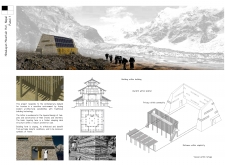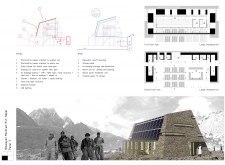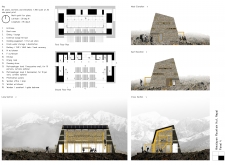5 key facts about this project
This project represents a fusion of modern design principles with traditional building techniques, resulting in a structure that is not only appealing but also practical. It serves as a shelter for trekkers and mountaineers, providing refuge and comfort after long days spent exploring the challenging landscapes. The architectural design emphasizes community and privacy, ensuring that while it caters to groups, there are also intimate spaces that allow for individual reflection and rest.
At the heart of the design is a layered structure that incorporates a timber sleeping deck nestled within a protective stone wall. This unique configuration appeals to both aesthetic and functional demands. The use of stone for the outer walls provides a robust defense against the elements, while timber adds warmth and a sense of connection to the region’s vernacular architecture. The project’s elevations reveal these carefully considered materials, demonstrating how they interact with light and shadow throughout the day.
One of the noteworthy features of the Himalayan Mountain Hut is its emphasis on sustainability. The integration of solar photovoltaic panels on the roof allows the structure to harness renewable energy, addressing the need for power while minimizing environmental impact. Additionally, rainwater harvesting systems are incorporated, supporting water availability for the hut’s amenities and ensuring that the project respects the fragile ecosystem of the Himalayas.
Architecturally, the hut is well-organized, with essential elements not only providing shelter but also fostering a sense of community among guests. A central dining and lounge area serves as a focal point, encouraging social interaction while offering sweeping views of the majestic landscape through large windows. The design also includes private sleeping quarters that prioritize comfort and privacy, arranged strategically to maximize available space. Mezzanine levels enhance the accommodation potential, allowing for additional sleeping areas and contributing to the overall spacious feel within a compact footprint.
Unique design approaches characterize the project. The synthesis of contemporary aesthetics with local materials and construction methods speaks to a broader conversation in architecture about contextual design. By honoring traditional forms while integrating modern technology, the hut achieves a balance that is both respectful and forward-thinking. The architectural details, such as the careful consideration of material choice and the layering of elements, underscore a commitment to craftsmanship and longevity.
The Himalayan Mountain Hut stands as a noteworthy example of how architecture can respond thoughtfully to its surroundings and the needs of those who utilize it. This project not only offers shelter but also creates an immersive experience that encourages appreciation for the spectacular natural environment it inhabits. For those intrigued by the architectural plans, sections, and overall design, exploring the detailed presentation will provide deeper insight into the innovative ideas and meticulous thought behind this remarkable architectural endeavor.


























